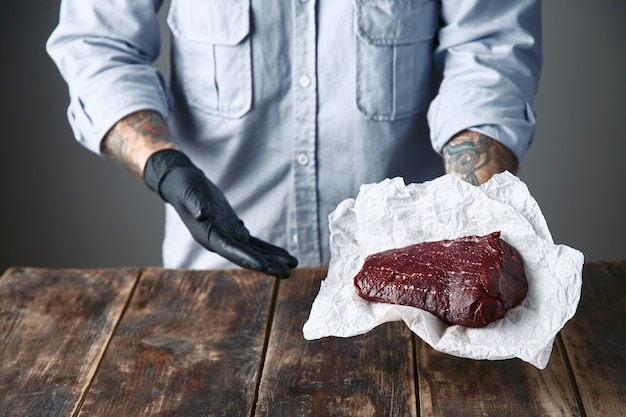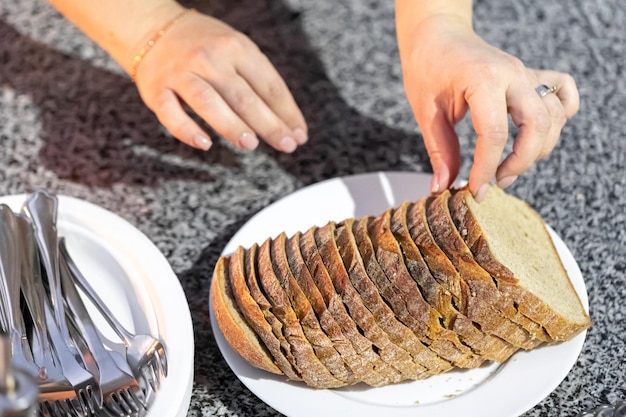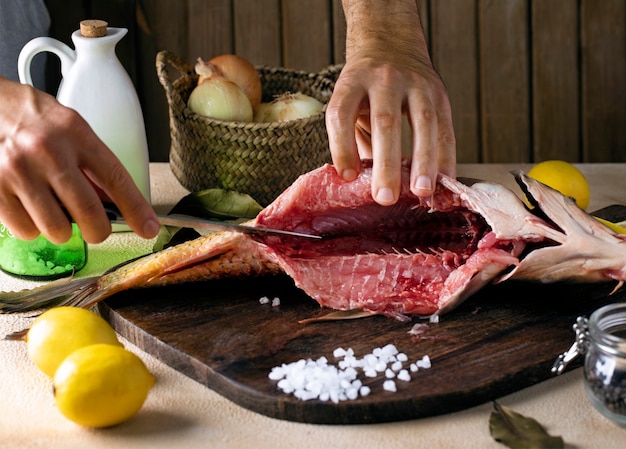Let's talk brisket, folks! I've been crafting brisket for years, and it's truly a labour of love. There's something magical about transforming a tough cut of meat into something so gloriously tender and bursting with flavour. It's not about rushing; it's about slow, deliberate cooking that allows the flavours to develop and the meat to break down, revealing its true potential. But don't worry, I'm here to guide you through every step, making this barbecue masterpiece achievable for anyone with a passion for good food and a little bit of patience.
(Part 1) Choosing the Perfect Piece

The journey to brisket brilliance starts with choosing the right piece of meat. Now, I'm a big fan of the whole packer brisket, which includes both the point and the flat. You've got more meat to work with, and the point adds a rich, fatty richness that elevates the entire dish. However, if you're just starting out, a flat brisket is a good choice. It's leaner, making it a good option for those watching their fat intake.
Looking for the Perfect Cut:
- Marbling Matters: You want good marbling - those white streaks of fat running through the meat. It's where the flavour comes from, so the more marbling, the better. Look for a good balance of fat and lean, ensuring a juicy and flavourful final product.
- A Deep Red Hue: A good brisket should have a rich, deep red color. Avoid any that look pale or have a greyish tinge, as this may indicate poor quality or improper handling.
- Firm and Springy: Give the brisket a gentle touch. It should feel firm and springy, not squishy or mushy. This indicates a healthy piece of meat that will hold its shape during cooking.
(Part 2) The Art of Trimming and Seasoning

Alright, you've got your brisket. Now, it's time to get down to business. The first step is trimming any excess fat. You don't want to remove all of it, as the fat renders down and adds flavour, but trim off any thick layers and excess fat around the edges. You want a nice, even layer of fat across the brisket, ensuring consistent cooking and a beautiful, golden-brown bark.
Seasoning Strategies:
- Simple is Best: My go-to is a simple rub of salt, pepper, and garlic powder. It lets the natural flavour of the beef shine through. Don't be afraid to experiment with other spices like paprika, cumin, onion powder, or chili powder, but remember to keep it balanced and let the beef be the star of the show.
- Salt's Essential Role: Don't be shy with the salt! Salt helps to break down the proteins in the meat, resulting in a more tender brisket. Season generously on all sides, ensuring even distribution for optimal flavour penetration.
- The Power of Injecting: Injecting is a great way to add extra moisture and flavour, especially for leaner cuts. You can use a simple broth or a custom blend of spices and flavours. I prefer a simple mix of beef broth, apple juice, and Worcestershire sauce. Inject evenly throughout the brisket, being careful not to overfill the meat and potentially cause it to burst.
(Part 3) The Smoke-Filled Journey

Now, the heart of the matter: the smoking process. It's a slow and steady affair, but the results are well worth the wait. You'll need a smoker, whether it be offset, pellet, or even a simple grill with a smoker box. The key is to maintain a consistent low temperature, allowing the magic of smoke and time to work their wonders.
Maintaining the Right Temperature:
- The Goldilocks Zone: You want to smoke your brisket at a temperature between 225-250°F (107-121°C). This low and slow heat allows the collagen in the meat to break down, resulting in that melt-in-your-mouth texture. It also allows the smoke to penetrate the meat, adding a delightful smoky flavour that can't be replicated any other way.
- Monitoring the Temperature: You'll need a meat thermometer to monitor the internal temperature of the brisket. You want it to reach an internal temperature of 190°F (88°C) for the flat and 203°F (95°C) for the point. This ensures the meat is cooked through and safe to eat, while still maintaining its tenderness and juiciness.
The Art of Smoke:
- Choosing Your Wood: The type of wood you use will affect the flavour of your brisket. Hickory, oak, and mesquite are popular choices, but feel free to experiment with different woods. Each wood has its own unique flavour profile that can complement the brisket in different ways. Just remember to use wood that has been properly dried and seasoned to avoid unwanted smoke that can overpower the flavour.
- Smoke Management: Don't overdo the smoke! Too much smoke can overpower the flavour of the brisket. Start with a few pieces of wood and add more as needed throughout the cooking process. You want a subtle smoky flavour that enhances the beef, not overpowers it.
(Part 4) The Wrap: A Crucial Step Towards Tenderness
After about 6-8 hours of smoking, you'll notice the brisket has developed a nice bark on the outside, and the fat is starting to render. This is when the magic happens - the wrap! I'm a big fan of the "texas crutch," which involves wrapping the brisket in butcher paper. It creates a moist environment that helps the meat to cook evenly and become unbelievably tender.
Why Wrap?
- Tenderness on a Whole New Level: The wrap helps to create steam, which accelerates the breakdown of collagen and makes the brisket even more tender. It's like giving the meat a warm hug, allowing it to relax and become incredibly soft and yielding.
- Locking in Moisture: The wrap prevents the brisket from drying out, ensuring a juicy and flavourful result. It's like creating a mini-steamer for the brisket, allowing it to cook in its own juices and retain its natural moisture.
(Part 5) The Stall: Understanding the Meat's Defense
Now, you'll likely encounter something called the "stall." This is a plateau in the brisket's internal temperature, usually around 160-170°F (71-77°C). Don't worry, this is normal! It's the meat's natural defense mechanism against overcooking. It's like the meat saying, "Hold on, I'm not ready yet!" You can keep the smoke going, but don't be surprised if the temperature stalls for a while.
Overcoming the Stall:
- Patience is the Key: Just be patient and let the brisket continue cooking. It will eventually break through the stall and continue to climb in temperature, revealing its true potential. Think of it as a test of your commitment to the perfect brisket.
- Adding Moisture: If the stall is lasting a long time, you can try adding a little bit of water to the smoker pan. This will help to create steam and help the brisket cook more evenly. This is a way to give the meat a little extra encouragement to break through the stall and reach that perfect temperature.
(Part 6) The Rest: Allowing the Flavour to Bloom
Once your brisket reaches the desired internal temperature, it's time to take it off the smoker. But don't rush into slicing it just yet! You need to let it rest. This allows the juices to redistribute throughout the meat, resulting in a more tender and flavorful brisket. It's like giving the meat a chance to catch its breath and allow the flavours to settle in.
Why Rest?
- Juice Redistribution: As the brisket cools, the juices that have been drawn out during cooking are reabsorbed into the meat. This makes the brisket juicy and flavorful, ensuring each bite is a symphony of tender meat and rich, savory juices.
- Improved Texture: Resting also allows the muscle fibers to relax, making the brisket even more tender. It's like giving the meat a chance to relax and become even more yielding, creating a truly melt-in-your-mouth experience.
How to Rest:
- Wrap it Up: Wrap the brisket tightly in butcher paper or foil and let it rest for at least 2 hours, or even longer if you can manage. Think of it as a cozy blanket for the brisket, keeping it warm and allowing the flavours to meld.
- Keep it Warm: You can place the brisket in a cooler or insulated container to keep it warm while it rests. This helps to maintain the meat's temperature and prevent it from becoming cold and stiff. You want to make sure the brisket stays warm and inviting, ready for its grand entrance.
(Part 7) The Art of Slicing and Serving: Showcasing Brisket's Glory
After a good rest, the moment of truth: slicing the brisket. This is where a sharp knife comes in handy. I like to slice against the grain, which helps to create a more tender bite. You can slice the brisket into thin, even slices or thicker, more rustic pieces. The choice is yours, depending on your preference and the occasion.
Serving Suggestions:
- Classic BBQ: Serve the brisket on a bun with your favorite bbq sauce, pickles, onions, and coleslaw. You can't go wrong with this classic combination. It's a timeless pairing that highlights the smoky and savory flavour of the brisket.
- Beyond the Bun: Get creative with your serving! Try brisket tacos, brisket nachos, or brisket sandwiches on toasted ciabatta bread. The possibilities are endless when it comes to showcasing the versatility of brisket.
- Leftovers: Don't forget about the leftovers! Brisket is great for sandwiches, salads, or even shredded into chili or tacos. It's a true chameleon of the culinary world, transforming effortlessly into a variety of dishes.
(Part 8) Mastering the Art of Brisket: My Tips and Tricks
Now, I've given you the basics, but here's where my own experience comes in. These are some tips and tricks I've learned along the way, adding a personal touch and a few shortcuts to make your brisket journey even more rewarding.
Tips:
- Don't be Afraid to Experiment: Everyone has their own preferred method for making brisket. Don't be afraid to experiment with different seasonings, woods, and cooking times to find what you like best. There's no one right way to make brisket, so embrace your creativity and find what suits your palate.
- Use a Thermometer: A good meat thermometer is essential for accurate temperature readings. It's the only way to ensure your brisket is cooked to perfection, ensuring a safe and delicious final product.
- Keep it Moist: A dry brisket is a sad brisket. Make sure to keep the smoker pan filled with water to maintain moisture during the cooking process. It's like giving the meat a sip of water to keep it hydrated and juicy throughout the long cooking process.
- Patience is a Virtue: Brisket is not a quick and easy meal. It takes time and patience. But trust me, the results are worth it. Think of it as a journey, where each step brings you closer to a truly remarkable culinary experience.
Tricks:
- Spritzing: Spritzing the brisket with apple juice or water during the cooking process helps to keep the meat moist and prevents it from drying out. It's like giving the brisket a refreshing mist to keep it hydrated and juicy.
- The "reverse sear": For a crispy bark and a juicy interior, try the "reverse sear" method. Cook the brisket low and slow until it's nearly done, then finish it off on high heat for a few minutes to sear the outside. It's like giving the brisket a final flourish, creating a beautifully browned bark that contrasts with the tender interior.
- Make Use of the Fat: Don't throw away the fat that renders from the brisket. You can use it to make delicious gravy or to add flavour to other dishes. It's like turning a byproduct into a culinary treasure, adding richness and depth to other recipes.
(Part 9) Brisket Beyond the Barbecue: A culinary adventure
Okay, so you've mastered the art of smoking brisket. But did you know you can cook a killer brisket in the oven, too? It's not as traditional, but it's a great option if you don't have a smoker. It's a testament to the versatility of this amazing cut of meat.
oven brisket:
- Slow and Steady: Preheat your oven to 300°F (149°C). Place the brisket in a roasting pan, fat side up. Add a cup of water to the pan to keep the meat moist. Cook for 4-6 hours, or until the brisket reaches an internal temperature of 190°F (88°C) for the flat and 203°F (95°C) for the point. Let the oven do its magic, slowly transforming the brisket into a tender masterpiece.
- The Wrap: You can still wrap the brisket in butcher paper or foil during the last couple of hours of cooking to enhance tenderness. It's like giving the brisket a warm hug, creating a steamy environment that helps to break down the collagen and create an incredibly tender result.
- Rest and Enjoy: After cooking, let the brisket rest for at least 2 hours before slicing and serving. Allow the flavours to settle in and the juices to redistribute, ensuring every bite is a delicious reward for your efforts.
(Part 10) FAQs: Your Burning Questions Answered
I know you might have some questions. Here are some common ones I get asked about brisket, along with my tips and tricks:
Q1: How long does it take to smoke a brisket?
The time it takes to smoke a brisket can vary depending on the size of the brisket and the temperature of your smoker. Generally, a whole packer brisket will take around 12-18 hours to cook. It's a long process, but the results are well worth the wait. Think of it as a slow-burning passion for deliciousness.
Q2: How do I know if my brisket is done?
You'll know your brisket is done when it reaches an internal temperature of 190°F (88°C) for the flat and 203°F (95°C) for the point. It should also be very tender, and the fat should have rendered down. The meat should literally fall apart, revealing its tender and juicy core.
Q3: Can I freeze brisket?
Yes, you can freeze brisket. Wrap it tightly in plastic wrap and then in foil before placing it in the freezer. It will last in the freezer for up to 3 months. Thaw the brisket in the refrigerator overnight before cooking. Freezing brisket is a great way to have it on hand for future meals, ensuring you have a delicious and convenient option ready to go.
Q4: What if my brisket is too dry?
If your brisket is too dry, it's likely that you didn't cook it low and slow enough, or you may have overcooked it. You can try to reheat the brisket with some liquid, like broth or apple juice, to help moisten it. You can also try shredding the brisket and using it in a dish like chili or tacos. Don't fret if it's a little dry; there are ways to salvage and even enhance its flavour!
Q5: What's the best BBQ sauce to use?
That's a matter of personal preference. Some popular choices include Kansas City-style sauces, which are thick and sweet, and Carolina-style sauces, which are vinegary and tangy. Experiment to find the sauce that best suits your taste. There's a whole world of barbecue sauce to explore, and you might even find your own signature blend!
And there you have it, folks! The ultimate guide to brisket mastery. Remember, it's all about patience, attention to detail, and a bit of love for the process. Now go forth and conquer the brisket, my friend! It's time to impress everyone with your barbecue skills and share your passion for this truly rewarding culinary adventure.
Everyone is watching

How to Cook Frozen Lobster Tails Perfectly: A Step-by-Step Guide
RecipesLobster. Just the word conjures up images of lavish meals, special occasions, and a taste of luxury. But let's...

Pigs in a Blanket Cooking Time: How Long to Bake for Perfect Results
RecipesAh, pigs in a blanket. Just the name conjures up images of those delightful little parcels of crispy pastry en...

Pork Fillet Cooking Time: How Long to Cook It Perfectly
RecipesPork fillet, or tenderloin as it's sometimes called, is a real favourite in our house. It's so versatile, and...

The Ultimate Guide to Cooking Delicious Frankfurters
RecipesLet's face it, we all love a good frankfurter. It's a classic, simple, and always satisfying. But let's be rea...

Wolf Meat Recipes: A Guide to Cooking Wild Game
RecipesLet's be honest, you don't see wolf meat at your local butcher shop every day. It's a bit of a wild card, but ...
